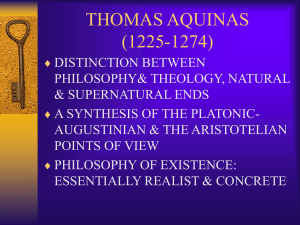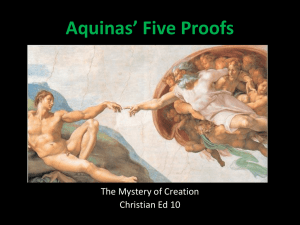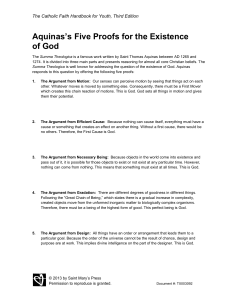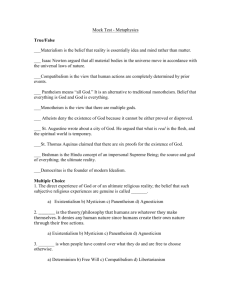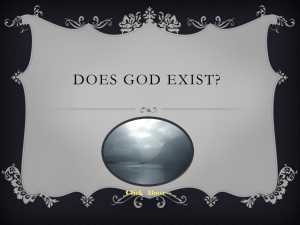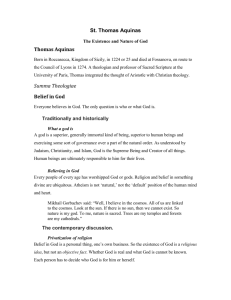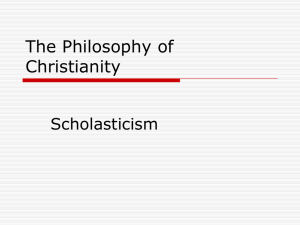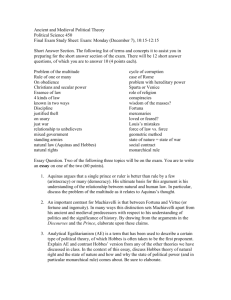Aquinas, the a priori/a posteriori distinction, and the Kantian
advertisement
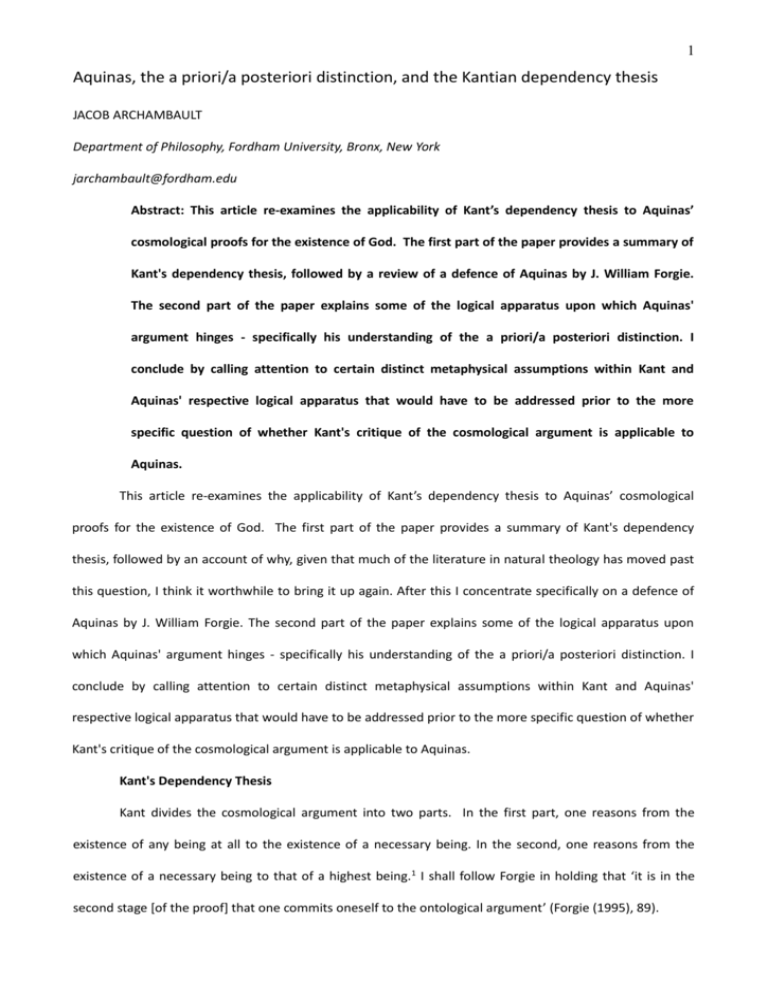
1 Aquinas, the a priori/a posteriori distinction, and the Kantian dependency thesis JACOB ARCHAMBAULT Department of Philosophy, Fordham University, Bronx, New York jarchambault@fordham.edu Abstract: This article re-examines the applicability of Kant’s dependency thesis to Aquinas’ cosmological proofs for the existence of God. The first part of the paper provides a summary of Kant's dependency thesis, followed by a review of a defence of Aquinas by J. William Forgie. The second part of the paper explains some of the logical apparatus upon which Aquinas' argument hinges - specifically his understanding of the a priori/a posteriori distinction. I conclude by calling attention to certain distinct metaphysical assumptions within Kant and Aquinas' respective logical apparatus that would have to be addressed prior to the more specific question of whether Kant's critique of the cosmological argument is applicable to Aquinas. This article re-examines the applicability of Kant’s dependency thesis to Aquinas’ cosmological proofs for the existence of God. The first part of the paper provides a summary of Kant's dependency thesis, followed by an account of why, given that much of the literature in natural theology has moved past this question, I think it worthwhile to bring it up again. After this I concentrate specifically on a defence of Aquinas by J. William Forgie. The second part of the paper explains some of the logical apparatus upon which Aquinas' argument hinges - specifically his understanding of the a priori/a posteriori distinction. I conclude by calling attention to certain distinct metaphysical assumptions within Kant and Aquinas' respective logical apparatus that would have to be addressed prior to the more specific question of whether Kant's critique of the cosmological argument is applicable to Aquinas. Kant's Dependency Thesis Kant divides the cosmological argument into two parts. In the first part, one reasons from the existence of any being at all to the existence of a necessary being. In the second, one reasons from the existence of a necessary being to that of a highest being.1 I shall follow Forgie in holding that ‘it is in the second stage [of the proof] that one commits oneself to the ontological argument’ (Forgie (1995), 89). 2 Kant himself details the problem with the second part of the cosmological proof as follows: Consider the proposition … that any absolutely necessary being is also the maximally real being. If this proposition is correct, then it must, like all affirmative judgements, be convertible at least per accidens - i.e., at least to this proposition: some maximally real beings are also absolutely necessary beings. However, one ens realissimum is in no respect different from another; and hence what holds for some beings contained under this concept holds also for all. Hence I shall (in this case) be able to convert the proposition also simply - i.e. to this one: any maximally real being is a necessary being. Now because this proposition is determined a priori and merely from its concepts, the mere concept of the maximally real being must carry with it also this Being’s absolute necessity. But this is precisely what the ontological proof asserted, and what the cosmological proof did not want to acknowledge but nonetheless laid at the basis of its inferences, although in a covert manner. (B 636-37) The relevant points of Kant's reasoning can be summarized as follows: Given the meaning of ens realissimum,2 it is impossible for anything that fits this description to have any qualities that another being fitting this description does not have - that is, every ens realissimum is identical to every other in every formal respect. Therefore, ‘any absolutely necessary being is an ens realissimum’ entails ‘any ens realissimum is an absolutely necessary being’. But since the truth of this statement is determined a priori by the meaning of the term ‘ens realissimum,’ for the cosmological argument to implicitly rely on it is for it to rely on the ontological argument; for that argument, in its most basic structure, is this generation of the claim ‘God exists’ from the concept of an ens realissimum. 6) Therefore, the cosmological arguer can only deny the probative force3 of the ontological proof at her own expense. Why reopen the question? Aquinas is commonly extricated from Kant's critique by pointing out certain differences between the version of the critique that Kant attacks and that which Aquinas advances. On Kant's side, it has been pointed out since Russell that the version of the cosmological argument that Kant critiques is not Aquinas', but is closer to those advanced by Leibniz and Wolff.4 Concomitantly, many commentators have pointed out that the notion of necessity used by Aquinas 3 in his five ways is different from that used by Kant. This point has been established by Peter Geach,5 Patterson Brown,6 Anthony Kenny,7 and William Rowe, among others, the last of whom writes the following: ‘Aquinas does not mean [by ‘necessary being’] a being whose non-existence is a logical impossibility. Instead, he means a being in which there is no capacity for generation and no capacity for corruption.’ (Rowe (1975), 40) This point is presumably meant to block Aquinas from Kant's critique in the following way: Kant's proof of DT relies crucially on the simple convertibility of ‘every absolutely necessary being is an ens realissimum’. But not only is this proposition not convertible simply on Aquinas' account: it is not even true, since other beings (e.g. angels and human souls) also necessarily exist. Therefore, though other arguments are susceptible to the DT, Aquinas' five ways do not fall within its scope. But this is not a sufficient defence of Aquinas. To make this clear, let us leave aside arguments in Aquinas’ five ways that are perhaps more covertly similar to Kant’s description and focus on the argument made by Aquinas that most explicitly resembles Kant’s reconstruction:8 Aquinas’ third way, the second half of which reads as follows: Every necessary being does or does not have the cause of its necessity from elsewhere. But it is not possible to proceed in infinitum among things that have a cause of their necessity, just as is the case with efficient causes, as was proven. Therefore, it is necessary to posit something that is per se necessary, not having the cause of its necessity from elsewhere, but itself being the cause of the necessity of other [necessary beings]: this all call God. (ST I. ii. 3, co)9 Here, ‘necessary being’ is not simply convertible with ‘highest being’. But this is largely irrelevant to Kant's critique: Kant's conversion is not one between ‘necessary being’ and ‘highest being,’ but one between ‘absolutely necessary being’ and ‘highest being’. And Aquinas has, if not exactly this, a very close analogue in his notion of a per se necessary being, which is convertible with ‘highest being’ - and this seems to situate Aquinas' third way directly in the scope of Kant's dependency thesis. As Forgie rightly points out, ‘We cannot free Aquinas from the DT by pointing out that he does not use a vulnerable notion of necessary being if in the end he uses the notion of uncaused necessary being in a vulnerable way.’ (Forgie (1995), 93). I take the above to establish two points: first, that one cannot assume that Aquinas' cosmological 4 proofs escape the scope of Kant's dependency thesis on the grounds that they are in many respects different from the Leibniz-Wolff token of the argument that Kant takes as his paradigm, since they have not been shown to be relevantly dissimilar; and second, that therefore, modern adaptations of Aquinas' natural theology that have thought themselves justified in leaving behind Kant on these grounds are in fact not so justified. Thus, the applicability of Kant's dependency thesis to Aquinas' five ways remains, at this point in our discussion, an open question. Forgie's Thesis In sum, the literature thus far attempts to extricate Aquinas from the DT by means of an evasion thesis: while Kant's dependency thesis remains a valid critique of certain cosmological arguments, Aquinas' happen to fall outside of its scope. Forgie himself has advanced an alternative defence of Aquinas against the DT, which aims not at evading, but rejecting it. Forgie takes Aquinas to hold that ‘God exists’ is not an a priori truth, which he takes from Aquinas' rejection of the ontological argument at ST I. ii. 1.10 Forgie then combines this with Aquinas’ statement that ‘God exists’ is per se notum secundum se - which he interprets as ‘necessarily true’ - to argue that ‘“God exists” is a necessary, but a posteriori truth. It is self-evident in itself, i.e., necessarily true, but not self-evident to us, i.e., not something whose truth can be seen simply by understanding it.’ (ibid., 99). Forgie's adopts this reading as a modification of a position taken up by Alvin Plantinga, who interprets Aquinas' distinction between per se nota quoad nos and in se propositions as one between a) propositions the truth of which is immediately knowable upon understanding, and b) necessary truths.11 But Plantinga also holds that ‘[t]he name ‘God’ in the sentence ‘God exists’ is not a proper name of God and does not serve to express the essence of God. Rather, that word is short for some such definite description as ‘the Creator and sustainer of all there is’ or perhaps ‘the first cause’ or 'the unmoved mover’’ (Plantinga (1975), 136). Consequently, the proposition uttered by us when we say ‘God exists’ is a contingent truth that is, it is contingent on His being the thing predicated of Him under the disguised description ‘God’, which He in every case could not have been had He chosen not to create. On the other hand, there is a different proposition ‘God exists,’ in which the name ‘God’ serves as a proper name. This proposition is 5 necessarily true, but unknowable to us.12 Forgie's critique of Plantinga's account,13 which I take to be sound, can be sketched as follows: 1) Aquinas holds that ‘God exists’ is a) self-evident in itself b) not self-evident to us, and c) demonstrable a posteriori - that is, on Plantinga's reading, it is a’) necessarily true, b’) not immediately graspable by the intellect, and c) demonstrable a posteriori. 2) But on this account, any form of the proposition ‘God exists’ that we can understand fails to satisfy the first criterion. Therefore, there is no proposition that we can understand that meets Aquinas' requirement of being self-evident in itself but not to us. 3) On the other hand, the proposition ‘God exists’ that is self-evident in itself - i.e. necessarily true - is unknowable. Therefore it is indemonstrable, and consequently not demonstrable a posteriori. Therefore, this proposition also fails to satisfy the three requirements that Aquinas thinks hold of some one proposition ‘God exists’. 4) Therefore, on Plantinga's account, there is, in fact, no one proposition that satisfies Aquinas description of the proposition ‘God exists’. 5) But on a straightforward reading of Aquinas,14 there is some such proposition. C) Therefore, Plantinga's reading of Aquinas on this point is likely mistaken. After refuting Plantinga's reading of Aquinas, Forgie puts forward an alternative interpretation of the proposition ‘God exists’ as Aquinas understands it: Suppose we think of proper names not as having 'senses' or as 'expressing' the essence, or any property of their bearers, and think of them instead more as Kripkean 'rigid designators', or in the way Mill thought of proper names - as terms which simply denote but lack connotation. Then we can regard the subject term 'God,' in 'God exists', as a proper name, not a disguised description, without requiring a grasp of the essence of God for the proposition to be intelligible. (Forgie (1995), 98-99) For some time, two things puzzled me about Forgie's argument up to this point. First, I did not understand the pertinence of the critique of Plantinga's exegesis of Aquinas to the question of how Aquinas is to be extricated from Kant's critique of the cosmological argument. Second, though Forgie does refute certain alternative positions attempting to defend Aquinas from Kant, he does not provide any direct support to the thesis in the paragraph quoted directly above: he neither a) puts forth reasons that show that the thesis successfully diffuses the DT, and does not merely disagree with it; nor b) brings forth additional texts to 6 confirm that the thesis is in fact held by Aquinas.15 Consequently, his thesis is expressed, towards the end of the argument, in the following conditional: ‘If there is no inconsistency in Aquinas' views then there must be something wrong with the DT.’ (ibid, 99). This, however, is just the contrapositive of a thesis that any prospective opponent of Forgie's would assent to, i.e. that if there is not something wrong with the DT, then Aquinas' position is inconsistent. Apology for Forgie Retrospectively, I would like to explain what I now take to be the unity and weight of Forgie’s argument. Though what I am about to say is not explicit in Forgie's paper, I take it to supply the implicit motive behind the critique of Plantinga, and shall allude to evidence in support of this position where necessary. Even apart from the question of whether Plantinga provides an adequate account of Aquinas' position, Plantinga's analysis of the proposition(s) ‘God exists’, thinks Forgie, is essentially incompatible with the thesis that ‘God exists’ is an a posteriori truth. This is because, in holding the name ‘God’ to be a disguised definite description, Plantinga has in advance set up the task of proving God's existence as being, to a large extent, engaged in discerning the meaning(s) of the name ‘God’. But meaning analysis is precisely the provenance of the a priori, and is only indirectly relevant to the a posteriori task of discerning matters of fact about the world. To put this another way, Forgie thinks that Plantinga's analysis relegates any possible theistic proof to the realm of sense when it should be engaged in fixing reference. Hence, he writes that Plantinga's descriptions ‘[only] provide the … meaning for 'God' in any intelligible proposition 'God exists’’ whereas these meanings should themselves ‘serve, in Kripke's idiom, to fix the reference of the name 'God'‘ (Forgie (1995), 98-99) - a service into which they cannot be pressed in Plantinga's own system on account of the depth of his apophaticism.16 This also explains why he mentions and criticizes Plantinga's comparing the truth of the proposition ‘God exists’ to that of Goldbach's conjecture, since this latter is, if true, not an a posteriori truth, but rather a synthetic a priori truth. Forgie's point here seems to be that on Plantinga's account, ‘God exists’ likely would be a synthetic a priori truth, whereas ‘for Aquinas, 'God exists' is not an a priori truth at all’ (Forgie (1995), 99). Now, thinks Forgie, since 1) Aquinas says that ‘God exists’ is known a posteriori; and 2) an a 7 posteriori truth is one about objects that can, at least in principle, be named, quantified over, put into a set, etc., it follows that 3) Aquinas' proofs must - like any a posteriori proof for the existence of God - be engaged in the task of fixing the reference of the name ‘God’. 4) Thus, though there are likely some differences, Aquinas' proofs must have been engaged in the same reference-fixing kind of work that today is best aided by recourse to the apparatus of Kripke's Naming and Necessity. Read this way, Forgie's conclusion is not meant to tie every loose end so much as to be a kind of instauration for research in natural theology. Given this, the arguments against Plantinga would not be construed as definitively entailing a Kripkean approach; but a step in that direction would likely be viewed as both the most natural and the most logical. Forgie writes: ‘We need an account in which the proposition 'God exists' satisfies all the conditions (a), (b) and (c).’17 The implication, if I am reading Forgie correctly, is that Kripke's account of names as rigid designators can do this, whereas no other well-known account can. The argument of Forgie's paper, then, can be summarized as follows: 1. If there is valid a posteriori proof for the existence of God (e.g. Aquinas’ third way), then it either merely evades the DT or rejects it. (Proofemp) (ET v ~DT) 2. ~ET (established in section I of Forgie's paper) 3. Furthermore, if there is a valid a posteriori proof for the existence of God , then the term ‘God’ in the proposition ‘God exists’ must be either treated as a disguised definite description or as a rigid designator. 4. If it is treated exclusively as a disguised description, then the dependency thesis remains valid (established in section II). Con. (Proofemp) (Plantinga v Kripke) (Plantinga DT) Therefore, if any of Aquinas' a posteriori theistic proofs are valid - that is, if he can establish that ‘God exists’ is necessary a posteriori - then the term ‘God’ must be treated as a rigid designator, and the dependency thesis must be rejected (Proofemp) (Kripke & ~DT)18 Forgie's conclusion is ambiguous insofar as it attempts to both a) lay the groundwork for further systematic work in natural theology, and b) establish an interpretation of Aquinas. The following section shall consist in a critique of third of the above premises. Specifically, I will show that the dichotomy in the consequent it fails to encompass Aquinas’ actual position, thereby depriving the conditional of its pragmatic 8 force.19 In other words, I shall undermine Forgie's philosophical hypothesis by showing his interpretive hypothesis to be mistaken. Critique of Forgie's account of per se nota propositions. Forgie's dilemma between Kripkean and Plantingan analyses of the term ‘God’ in the proposition ‘God exists’ arises from a) his gloss of Aquinas' per se notum secundum se/quoad nos distinction; and b) his understanding of the a priori/a posteriori distinction: ‘God exists’ must be necessary, but not a priori; if a proof is conducted in Plantinga's manner then it is a priori; this leaves a Kripkean analysis as the only, best, or most obvious means by which to ensure that ‘God exists’ be an a posteriori truth. A minor objection to Forgie's gloss is that Aquinas already has an a priori/a posteriori distinction, as well as a distinction between necessary and contingent truths. Given this, the lexical items ‘per se notum quoad nos’ and ‘per se notum secundum se’ would seem to serve no unique purpose in Aquinas' language. This superfluity would add unnecessary confusion to the expositions of an otherwise generally lucid and clear writer: in other words, Aquinas could have simply said that ‘God exists’ is necessary and a posteriori instead of developing additional vocabulary that could potentially mislead his reader. But more decisively, Forgie's interpretation of Aquinas schema of per se nota truths is inconsistent with Aquinas’ own remarks on the subject. To show this, let us compare Forgie's account with Aquinas' own. Aquinas writes: Something's being self-evident occurs in two ways: in one way, in itself and not to us; in the other way, in itself and to us. From this some proposition is per se nota: that its predicate is included in the meaning of the subject ... If, then, the quiddity of the predicate and subject is understood by all, the proposition [that combines them] will be per se nota to everyone … But if the quiddity of the subject and predicate is not known to some, then that proposition will be per se nota in itself, but not among those who do not understand the subject and predicate of the proposition. And therefore it happens, as Boethius states in his book de hebdomadibus, that certain conceptions of the soul are common and per se nota only among the wise. (ST I. ii. 1, co)20 Now in the first sentence of the above, Aquinas makes it clear that every per se nota proposition is per se nota secundum se. From here, this group of all per se notae propositions is divided into those that a) are 9 and b) are not per se notae quoad nos. To put this into Aquinas' own parlance, we might say that the relationship between secundum se and quoad nos per se notae propositions is one of genus to difference. This means, in principle, that Aquinas' larger category of per se notae secundum se propositions is divided by one easily distinguishable factor into two distinct groups. Call this the genus-difference criterion (GDC). Furthermore, Aquinas delimits per se notae secundum se propositions as those having the following mark: the predicate is included in the meaning of the subject. Let us call this the subject-predicate containment criterion, or the containment criterion (CC) for short. Forgie's Aquinas has problems with meeting both the GDC and the CC. Concerning the former, Forgie construes per se nota secundum se as ‘necessary truth’. But he is ambivalent regarding the demarcation the sphere of per se notum quoad nos propositions. Recall that he writes that ‘'God exists' is a necessary, but a posteriori truth. It is self-evident in itself, i.e., necessarily true, but not self-evident to us, i.e., not something whose truth can be seen simply by understanding it.’ (Forgie (1995), 99). Here, the parallelism in the first half of the two sentences can be interpreted as implying or not implying parallelism in the latter half. If the implication is there, ‘not self-evident to us’ would be coextensive with ‘a posteriori’. But this cannot be the case, because Forgie presumably does not think that all a posteriori truths are necessary, as would be the case if ‘necessary’ were a genus of ‘a posteriori’. If, on the other hand, ‘not self-evident to us’ is not coextensive with ‘a posteriori,’ but perhaps includes, for instance, certain synthetic a priori truths as well, then the unity of the category as a whole would be left vague. Depending on how this unity is construed, Forgie's Aquinas might still be unable to adequately account for the existence of both necessary and contingent a posteriori truths. Furthermore, by virtue of the CC, the necessarily true propositions must be those wherein the predicate is included in the meaning of the subject. Therefore, Forgie cannot both hold that ‘God exists’ is a necessary truth, and that ‘God’ in the a posteriori, necessarily true proposition ‘God exists’ is a rigid designator - that is, it is a term ‘which simply denote[s], but lack[s] connotation’ (ibid., 98). On account of the former, it follows that the predicate ‘exists’ must be contained in the meaning of ‘God’. But on account of the latter thesis, the name ‘God,’ must be literally meaning-less: it does not contain within it any sense or property, and consequently, does not contain within it the sense or property ‘exists’. Therefore, ‘God exists’ 10 both would and would not be a necessary truth. Perhaps Forgie can avoid this problem by holding that it is not ‘God’ that must contain within itself the predicate ‘exists,’21 but God, who contains the predicate ‘existence’ by actually existing. More generally, a subject (b) would be said to contain its predicate (F) simply by being F. But this account cannot work either, since the propositions that meet the containment criterion must be coextensive with the necessary truths. If, then, for some subject (b) to contain the predicate (F) is interpreted simply as (Fb), then it follows that all truths are necessary truths. But Aquinas clearly intends that the propositions that are per se notae secundum se are only a subset of all true propositions. Therefore, Forgie's reading on the above points must be mistaken. Forgie's a priori/a posteriori distinction Having addressed the problems in Forgie's account of the per se nota in se/quoad nos distinction, let us take a look at his understanding of the a priori/a posteriori distinction. As alluded to earlier, Forgie seems to adopt a rigid-designator approach to the term ‘God’ because he regards all theistic proofs that are exclusively focused on an analysis of the meaning of the term ‘God’ as a priori proofs. Consequently, he thinks that an a posteriori proof must be one that is not about sense, but about reference, though it may take the senses of Plantinga's disguised predicate(s) ‘God’ into account. In other words, Forgie understands the a priori/a posteriori distinction regionally - that is, as a distinction between two different kinds of truths, presumably dealing with different kinds of objects. In this case, the a priori truths are those concerning the meaning of terms, while the a posteriori truths are those concerning referents. The problem of proving God's existence, then, becomes one of closing the gap between the thing and the thought. This is apparent in Forgie's partial rehabilitation of Plantinga when he states ‘The descriptions which, on Plantinga's view, provide the only possible meaning for 'God' in any intelligible proposition 'God exists', can still play a useful role in making that proposition intelligible. They can serve, in Kripke's idiom, to fix the reference of the name 'God.'‘ (Forgie (1995, 98-99) This specific way of thinking about the a priori/a posteriori distinction is not unique to Forgie. But let us notice also that within the wider category of what I will broadly call the regional a priori, there are different permutations. For instance, there is a nominalist brand, according to which the a priori truths are 11 those concerned with the meaning of terms.22 But there is also a conceptualist brand, of which we might take David Hume's a priori/a posteriori distinction between relations of ideas and matters of fact as an example.23 In fact, one might be inclined to think of the a priori/a posteriori distinction regionally by something as simple as the phrase ‘a priori and a posteriori truths,’ which seems to suggest that the two are distinguished as different kinds of truths. Let us return, for a moment, to Kant and Aquinas. Let us first note that in spite of having an impact on ST I. ii. 3, Kant’s critique is not directed at the question of whether God exists; rather, Kant’s critique is explicitly directed at the possibility of proofs for God’s existence, a matter that Thomas treats of in ST I. ii. 2. In this article, Aquinas presents three objections to the position that he will ultimately defend. The first objection, which derives the unprovability of God’s existence from its status as an article of faith, shall not concern us here. Nor shall the third, since it begins from premises that Kant himself would not accept.24 But the second shall, since it has a direct parallel in Kant’s critique of cosmological proofs. The text of Aquinas’ second objection reads as follows: The medium of a demonstration is what a thing is (quod quid est). But we are not able to know of God what he is, but only what he is not, as John of Damascus states. Therefore, we are not able to demonstrate God's existence. (ST I. ii. 2, arg. 2)25 We can see Kant endorsing the major premise of the argument in this passage: Only an apodeictic proof insofar as it is also intuitive can be called a demonstration. Now experience indeed teaches us what is, but not that it cannot possibly be different. Hence empirical bases of proof can provide no apodeictic proof at all. (B 762) In the above passage, Kant rejects the possibility of empirical or a posteriori demonstration altogether. This means that for Kant, one can only arrive at a necessary truth by means of a deduction from the idea or concept of the thing, which is roughly similar to what Aquinas calls the essence or quiddity of the thing, designated in the above passage by the phrase ‘quod quid est’. Within the context of Kant’s critique of the ontological argument, this means that any demonstration that God necessarily exists must take the form of a deduction from the concept of God - that is, it must deduce existence from the concept of an ens realissimum: Medium demonstrationis est quod quid est. 12 Kant’s acceptance of the second premise may be brought home by the following text: The transcendental idea of a necessary and all-sufficient original being is so exceedingly large and so highly exalted above everything empirical, which is always conditioned, that partly one can never turn up enough material in experience to fill such a concept, and partly one is always groping about in what is conditioned and will forever search in vain for the unconditioned. (B 649) In other words, we cannot know the essence of God for two reasons: first, the idea of God is, by its sheer magnitude, incompletable by finite human thought; second, it is, for the same reason, wholly inadequate to experience, which is always finite and conditioned. Ergo, God’s existence is indemonstrable. Let us put the above in another way. According to Kant, an apodictic proof proceeds by way of a deduction from the concept - that is, it is broadly concerned with the sphere of meaning.26 But according to Kant, the content of the idea of a perfect being is, by its very nature, such that it cannot be applied to the regional empirical sphere of things - that is, the concept is just too large for us to find anything empirically adequate to it: in order to be shown to be veridical, the idea of God must be adequate to something that by definition it cannot be adequate to. Thus, like Forgie, Kant's a priori/a posteriori distinction gives rise to a specific kind of adequatio problem, viz., how the concept of God can ‘traverse the gap’ from pure concept to reality.27 This understanding of the a priori/a posteriori distinction is also at work in Kant's analysis of the cosmological argument, which Forgie does not contest. In the first step, one reasons from some being to a necessary being. In the second, one determines the concept or nature of this necessary being.28 Kant's analysis spends very little time on the analysis of the first step, doubtless because he thinks that it is the second step that does all the work of proving the existence of God, and not merely of some anonymous necessary being. Whether these steps are temporally consecutive, as in Kant, or intertwined, as is perhaps the case with Forgie, is immaterial: on either account, the first part of the argument - that is, that which is a posteriori proper - is insufficient of itself to make the statement ‘God exists’ meaningful, and is at best engaged in the preparatory work of getting the ontological argument's divine-attributes-generator started. In short, the regional a priori/a posteriori distinction is problematic for a posteriori proofs of God's existence, thus leaving Forgie's Kripkean approach to a posteriori proof not nearly as promising as Forgie 13 regards it as being. In what follows, I hope to show that Aquinas' understanding of the a posteriori/a priori distinction is sufficiently different from the one that, in its most basic aspects, is shared both by Kant, Plantinga, and Forgie. Aporiae: Translating Aquinas Aquinas’ response to the second objection of ST I.ii.2 is to state that one can demonstrate the existence of God by means of effects. Aquinas writes:29 Ad secundum dicendum quod cum demonstratur causa per effectum, necesse est uti effectu loco definitionis causae, ad probandum causam esse, et hoc maxime contingit in Deo. Quia ad probandum aliquid esse, necesse est accipere pro medio quid significet nomen non autem quod quid est, quia quaestio quid est, sequitur ad quaestionem an est. Nomina autem Dei imponuntur ab effectibus, ut postea ostendetur, unde, demonstrando Deum esse per effectum, accipere possumus pro medio quid significet hoc nomen Deus. (ST I. ii. 2, ad 2)30 Several things that Aquinas says in this passage ought to be puzzling, and so we will draw our attention to these. First, let us notice the phrase ‘necesse est uti effectu loco definitionis causae,’ which might be most commonly translated as ‘it is necessary to use an effect in place of the definition of the cause’ when proving a cause to exist. What is so strange about this is that Aquinas tells us in a passage from his commentary on the Posterior Analytics that every demonstration is a syllogism,31 and effects are simply not the kinds of things that find their way into syllogisms: terms and definitions are. So we might be inclined to think that Aquinas is being a bit imprecise with his words, and is intending to speak about the meaning or definition of the effect as what belongs in the syllogism, and not the effect itself. The second place to which we must turn is the phrase, ‘necesse est accipere pro medio quid significet nomen,’ which might be translated as, ‘it is necessary to take up the meaning of the name [in this case, the name ‘God’] as a middle term’ in the syllogism where one attempts to prove God’s existence. Here again we can ask the following question: what is meant by ‘significet’ here? The translation of ‘means’ seems to make the most sense contextually, but is awkward in another sense, vis., ‘signification’ is not usually thought of as a meaning relation at all. Instead of being a relation of things to their meanings, signification tends to either be a relation between different things - as, e.g., when dark clouds signify 14 inclement weather - or, a relation of words as signifiers to their associated things, or significata. In other words, ‘signification’ in this latter sense is more likely to be taken as a synonym for ‘reference’ than for ‘meaning’. And if this is the case, then it seems that the phrase ‘necesse est accipere pro medio quid significet nomen,’ when the name In question is ‘God’, entails the presence of an all-powerful being in the middle of one’s syllogism, which is, well, a bit strange to say the least. But suppose that we prescind from the above concerns. Suppose that we are able to determine how the phrase ‘quid significet nomen’ should be translated by looking at how Aquinas practically applies the principle in ST I. ii. 3. In particular, we may have recourse to the frequent use of phrases like ‘and this all men call God’ to suggest that the name ‘God’ signifies an unmoved prime mover, a first efficient cause, etc., and thus conclude that it is these descriptive phrases that, Aquinas says, need to be taken up as middle terms in our syllogism. But if this is what Aquinas means, then given that our conclusion is to be ‘God exists’ our syllogism must - while perhaps leaving room for various sub proofs - take the following form: Major premise: It pertains to a per se necessary being to exist. Minor premise: God is a per se necessary being Conclusion: God exists. This is, of course, formally identical to the ontological proof: Major premise: Existence belongs to that than which nothing greater can be thought Minor premise: God is that than which nothing greater can be thought Conclusion: God exists. This fact should again raise the suspicion that Aquinas will not be able to prove God’s existence without also validating the ontological proof that he rejects. In short, all of the above suggest a dilemma for the translator: either a) adopt a loose translation that allows the argument to maintain a degree of strength and sensibility, while running the risk of interpolation and misconstrual; or b) adopt a literal translation that seems to let Aquinas speak for himself, but leaves his argument open to objection, weak, and in some places simply incongruous. How to navigate this dilemma will be shown in the following section. A priori and a posteriori according to Aquinas 15 In the body of article two, Aquinas writes the following: It must be said that there are two kinds of demonstration: one which is through a cause, and is called propter quid, and this is through what is prior simply; the other is through an effect, and is called a demonstratio quia, and this is through those things that are prior quoad nos. For since some effects are more manifest to us than their causes, we proceed through the effect to cognition of the cause. (ST I. ii. 2, co)32 In order to understand Aquinas' distinction between quia and propter quid demonstrations here, it is best to turn to his commentary on Aristotle's Posterior Analytics I. xxiii. This should in turn shed light on Aquinas’ use of terms in his response to the second objection cited above. Let us first note that the distinction between quia and propter quid demonstrations is not a distinction between hypothetico-deductive models of demonstration, plagued as they are with problems of underdetermination,33 and logical/mathematical modes of demonstration, which are more certain but less applicable. Rather, in accord with Aquinas’ understanding of demonstration, both are kinds of syllogisms.34 The dominant distinction between them is not one of logical structure, but one of the nature of the things treated: a demonstratio propter quid proceeds from causes to effects,35 while the category of demonstratio quia is divided into two types: the former being a demonstration proceeding from effects to causes; the latter, which shall not concern us since it has no bearing on Aquinas’ theistic proofs, Aquinas calls a demonstration per non immediata.36 To demonstrate the distinction between propter quid and the former type of quia demonstration, Aquinas explicates two examples taken from the Aristotelian text upon which he comments. The first example is given in the following syllogism, given within the implicit domain of astronomy: Major premise: Whatever does not twinkle is near Minor premise: Planets do not twinkle Conclusion: The planets are near. The second example, also taken from astronomy, is as follows: Major premise: Whatever waxes is spherical Minor premise: The moon waxes. 16 Conclusion: The moon is spherical According to Aquinas, both of these are quia demonstrations because, while they do suffice to give us new knowledge (e.g. that planets are near), they don’t provide the ‘why’ of this new knowledge. Instead, in these examples, the order by which the new fact is discovered is the opposite of the order by which it occurs in nature: the moon is not round because it waxes, but waxes because it is round. Hence Aquinas points out that if the effect and cause are coextensive, then the quia demonstration can be converted into a propter quid demonstration. This effectively solves the worry raised in the previous section - i.e. that Aquinas cannot prove God’s existence without also validating the ontological argument - by making it a moot point. Convertibility is not dependence. Aquinas will also point out that there are quia demonstrations that are unable to be converted into propter quid demonstrations - for instance, when the effect taken up as a middle term has a lesser scope than the major term.37 And here, Aquinas takes the following syllogism as his example: Major premise: Whatever moves by walking has a sensible soul Minor premise: x moves by walking Conclusion: x has a sensible soul In the above example, Aquinas takes ‘having a sensible soul’ to be the cause of the motion. But this does not entail that one can prove the specific kind of motion from the presence of a sensible soul (i.e. in a propter quid demonstration), since the presence of a sensible soul can presumably manifest itself through other kinds of motion. The proofs of God’s existence will all be quia demonstrations of this form. This means that God’s existence is bound to be beyond any of the significatory predications that are used to prove his existence, which entails two very important points for Aquinas about God: his uncircumscribability and his creative freedom. In other words, that God’s essence/existence is not logically convertible with any of his names ensures that God’s essence is never exhaustively captured by any name; and it also ensures that, while God’s existence is properly speaking, the cause of the various relations that the world has toward Him, it does not entail any of them: God’s existence does not necessitate that he be first efficient cause, or that he appear to Moses in a burning bush, since this existence could have manifested itself in totally different ways had God created the world differently, or not created at all. 17 At first sight, the above claim can easily be accused of confusing logical and metaphysical necessity. But to even make this kind of charge presupposes a kind of dichotomy between thought and being that Aquinas will not allow into his logic. This is already partially evident from the fact that Aquinas’ ‘logical’ distinction between propter quid and quia demonstrations is essentially a distinction between syllogisms that do and do not proceed by way of the natural order of causes. To prove this point, we may revisit the questions raised in the last section regarding Aquinas’ apparently imprecise use of language. Using the texts of ST I. ii. 2. already explicitly mentioned, we can also draw on parallel texts in the Summa Contra Gentiles and the commentary on Boethius’ De Trinitate to get the following two charts:38 ST I. ii. 2. Necesse est uti effectu loco definitionis causae ad probandum causam esse39 SCG I. xii Accipitur effectus loco quidditatis pro medio40 DT I. i. 2 Supplet forma effectus locum formae ipsius rei.41 ST I. ii. 2. Necesse est accipere quid significet nomen pro medio ad probandum aliquid esse42 ST I. ii. 2. Accipere possumus quid significet hoc nomen Deus pro medio43 Taken together, this says the following. In a propter quid demonstration, the medium (i.e. middle term) of a demonstration is the form of the subject, or quiddity, which, when spoken of in its relation to the intellect, is also called the definition or delimitation of the cause. But in a demonstratio quia, one takes up the form of the effect - or, more simply, the effect - as a medium to prove the existence of its cause. But this effect is not other than what the name itself signifies: therefore, whether signification is identified with meaning or reference, the name ‘God’ is neither purely connotative, as Plantinga’s Russellian disguised description model suggests, nor purely denotative, as Forgie’s Kripkean rigid designator model suggests. In a proof of the existence of God, one proceeds by way of two syllogisms: the first of which, which does the bulk of the work, uses the effect as the medium of demonstration to conclude to the existence of that which is signified 18 as its cause (e.g. prime mover, per se necessary being, etc.); the second of which, using the conclusion of the first syllogism as its major premise (e.g. ‘a prime mover exists’), and combined with some statement of the form ‘and this all call God’ as a minor, concludes to the proposition ‘God exists’. Conclusion I take the above to have established the following. First, Aquinas' logic is realist from the start: it is not primarily concerned with propositions or concepts (if this latter term is thought of as something distinct from the things to which they apply), but beings. This means that the problem of proving God's existence is, for Aquinas, neither one of ‘crossing the gap’ from the concepts, over to things, as for Kant, nor one of ‘fixing the reference’ of the term ‘God’ to God, as for Forgie, but - and herein lies both the simplicity and, from our perspective, the novelty of Aquinas' logic - one of actually coming to know God. Second, Aquinas' distinction between a priori and a posteriori truths is neither regional nor methodological, but aetiological - that is, it is defined by distinguishing between the hierarchical order of nature itself and the order in which we come to understand it. From this standpoint, attempts to ensure that ‘God exists’ be an a posteriori truth, along with all the worries motivating these attempts, constitute a category mistake: it is neither to propositions, nor truths, nor even methods to which the a priori/a posteriori distinction is rightly applied, but rather to demonstrations. Of itself, the above is not sufficient to show that Aquinas completely avoids the problems posed by Kant for theistic proofs, which would have to be supplemented by, among other things, an account of the role of Aristotle's doctrine of the categories, and specifically the category of relation, in Aquinas' theistic proofs in particular, and in his existence proofs in general. But hopefully what has been provided thus far has made the project of proving the existence of God that much more sensible. Abbreviations Works by Kant B = Critique of Pure Reason, tr. Werner S. Pluhar. (Indianapolis IN: Hackett, 1996). Cited according to the Akademie pagination of the second edition. Works by Aquinas 19 DT = Super librum Boethii de Trinitate (Rome : Editori di San Tommasso, 1992). Cited by part, question, and article PA = In Aristotelis Libros Posteriorum Analyticorum Expositio (Turin: Marietti, 1955). Cited by book, chapter, and paragraph. SCG = Summa Contra Gentiles (Turin: Marietti, 1961). Cited by book and chapter ST = Summa Theologiae: Prima Pars (Ottawa: Studia Generalis O. Pr., 1941). Cited by part, question, and article. References ANSCOMBE, G. E. M., AND P. T. GEACH (1961) Three Philosophers (Ithaca NY: Cornell University Press). BROWN, PATTERSON (1964) ‘St. Thomas’ Doctrine of Necessary Being’, The Philosophical Review 73, 76-90. CARNAP, RUDOLPH (1950) ‘Empiricism, Semantics, and Ontology’ Revue Internationale de Philosophie 4, 2040. FORGIE, J. WILLIAM (1995) ‘The Cosmological and Ontological Arguments: How Saint Thomas Solved the Kantian Problem’, Religious Studies 31, 89-100. GÖDEL, KURT (1951) ‘Some basic theorems on the foundations of mathematics and their implications’ in Gödel 1995, 304-323. GÖDEL, KURT (1995) Collected Works Volume 3: Unpublished Essays and Lectures eds Feferman et al. (Oxford: Oxford University Press). KENNY, ANTHONY (1969) The Five Ways: Saint Thomas Aquinas’ Proofs of God’s Existence (London: Routledge & K. Paul). KLIMA, GYULA (2002) ‘Aquinas’s Theory of the Copula and the Analogy of Being’ Logical Analysis and the History of Philosophy 5, 159-176. ORLEBEKE, CLIFTON J, AND LEWIS B. SMEDES, eds (1975) God and the Good: Essays in Honor of Henry Stob (Grand Rapids MI: Eerdmans). PLANTINGA, ALVIN (1975) ‘Aquinas on Anselm’ in Orlebeke and Smedes 1975. ROWE, WILLIAM L. (1975) The Cosmological Argument (Princeton NJ: Princeton University Press). RUSSELL, BERTRAND (1945) A History of Western Philosophy (New York NY: Simon and Schuster). 20 VALLICELLA, WILLIAM (2000) ‘Does the Cosmological Argument Depend on the Ontological?’ Faith and Philosophy 17, 441-458. 1 See B 632-33. Kant defines an ens realissimum as one determined ‘thoroughly and a priori … by one predicate from all possible 2 [pairs of] predicates’ (B 633). Thus, if one ens realissimum were to differ from another, it would have to differ by having some predicate different from the other. But since (by hypothesis), all of the predicates that belong to any ens realissimum are thoroughly determined and fixed, no ens realissimum can have predicates different from another, and therefore ‘is in no respect different from another’ (B 636). I take the term ‘probative force’ from Vallicella (2000), who delineates it as follows: ‘Thus a deductive argument is 3 probative only if it is (i) valid in point of logical form, has (ii) true premises that are (iii) known to be true, (iv) avoids a petitio principii, and (v) is such that the premises are relevant to the conclusion’ (442). 4 See Russell (1945), 587-588. See. P.T. Geach, ‘Aquinas’, in Anscombe and Geach (1961), 114. 5 6 See Brown (1964), passim. 7 See Kenny (1969), 42. 8 Taking this route may at first sight appear to make a straw man of Aquinas' natural theology. But my object is the opposite of this: to allow the full weight of Kant's critique to fall on Aquinas in order to cut short certain ‘easy routes’ out of the problem (e.g. by having only certain of Aquinas' five ways to fall within its scope) and to force a critical encounter between what is most essential in their respective positions. The impetus for this way of proceeding is adopted from Forgie 1995, p. 95. 9 ‘Omne autem necessarium vel habet causam suae necessitatis aliunde, vel non habet. Non est autem possibile quod procedatur in infinitum in necessariis quae habent causam suae necessitatis, sicut nec in causis efficientibus, ut probatum est. Ergo necesse est ponere aliquid quod sit per se necessarium, non habens causam necessitatis aliunde, sed quod est causa necessitatis aliis, quod omnes dicunt Deum.’ All Latin translations throughout this article are my own, unless otherwise noted. 10 11 See Forgie (1995), 95-96. ‘And if Aquinas is right, God's existence has just this status: it is self-evident in itself but not to us. It is a necessary truth that God exists, but not one we know just by understanding it.’ (Plantinga (1975), 136). 12 See Plantinga (1975), 138. 13 See Forgie (1995), 97-98. 14 Note critically, that this is what Plantinga takes himself to be engaged in. And given this intention, the reading is 21 implausible, since, apart from the conceptual apparatus that Plantinga himself brings to the table, there is nothing intrinsic to the passages under discussion that necessitates positing more than one proposition that satisfies Aquinas’ three criteria, and much that militates against it, e.g. Aquinas ascribes being per se nota secundum se, not being per se nota quoad nos, and being demonstrable from effects to the same grammatical subject at the end of the respondeo of ST I. ii. 1. Given that Plantinga’s reading fails in its explicit intention - an interpretation of the mind of the author - it a fortiori likely also fails as an attempt to read Thomas better than Thomas - for instance, to tease out an equivocation in Thomas’ response. While it would not be logically inconsistent to take Plantinga’s reading as the correct one, it would be presumptuous to do so without first attempting to make sense of Aquinas’ response in a manner more in accord with its prima facie meaning. 15 In fact, Forgie gives his reader some reason to suspect that he may be imposing his own views on Aquinas when he writes the following: ‘The criticism of the DT sketched here was earlier developed in my 'Kant on the Relation Between the Cosmological and Ontological Arguments', op. cit. I did not realize then that Aquinas had the material for making the same objection.’ (Forgie (1995), 99, fn. 22). 16 ‘Since we have no grasp of God’s essence, we have no grasp of this proposition [with the essence of God as its subject property]; we cannot assert it, deny it, doubt, or believe it – at least not in any straightforward manner.’ (Plantinga (1975), 138. 17 Ibid. The conditions are that ‘God exists’ be a) a posteriori, b) not self-evident, and c) necessarily true. 18 I leave it to the reader to fill in the details of the deduction. 19 By ‘pragmatic force,’ I mean the ability of a proposition to compel the one who understands it to a certain course of action. To guarantee pragmatic force a hypothetical proposition recommending a certain course of action need not be true, but it must a) appear to be so, and b) it must appear to be without significant competitors. In this case, Forgie's conditional in premise three recommends a certain course of action to the person who seeks an a posteriori proof for the existence of God (i.e. adopt a Kripkean rigid-designator approach) partially on the grounds that there are no readily apparent alternative courses of action that show a comparable degree of promise. 20 ‘Contingit aliquid esse per se notum dupliciter: uno modo, secundum se et non quoad nos; alio modo, secundum se et quoad nos. Ex hoc enim aliqua propositio est per se nota, quod praedicatum includitur in ratione subiecti ... Si igitur notum sit omnibus de praedicato et de subiecto quid sit, propositio illa erit omnibus per se nota ... Si autem apud aliquos notum non sit de praedicato et subiecto quid sit, propositio quidem quantum in se est, erit per se nota, non tamen apud illos qui praedicatum et subiectum propositionis ignorant. Et ideo contingit, ut dicit Boetius in libro de hebdomadibus, quod quaedam sunt communes animi conceptiones et per se notae, apud sapientes tantum.’ 21 For worries about existence as a predicate, see Klima (2002). 22 22 See Rudolph Carnap (1950), passim. 23 For a more recent example, cf. Gödel (1951). 24 Specifically, it accepts the idea that a posteriori demonstration is possible, which is rejected by Kant in B 762, cited below. ‘Medium demonstrationis est quod quid est. Sed de Deo non possumus scire quid est, sed solum quid non est, ut dicit 25 Damascenus. Ergo non possumus demonstrare Deum esse.’ 26 In Kant's case, this is construed on a conceptualist and not a nominalist schema. It should also be noted that Kant's regional a priori/a posteriori distinction is not one of truths or propositions, but of concepts, i.e. that between pure and empirical cognitions. See B1-3. But neither of these details substantially affects my argument here. 27 Note that this is not a general problem about the applicability of concepts to empirical reality, but a problem about the applicability of the concept of a divine being to that reality. 28 29 Or in Forgie's language, the second step applies predicates as a means of fixing reference. Since much of the discussion following concerns the question of how exactly to translate Aquinas' text, I have here chosen to quote the Latin here in the main body of my text, while relegating a provisional translation to the footnote. 30 ‘To the second it must be said that when a cause is demonstrated through an effect, it is necessary to be led by the effect in place of the definition of the cause toward the existence of the cause to be proven. And this is especially the case with God. For to prove anything's existence, it is necessary to accept as a medium what the name signifies, but not the quiddity (since the question of what [something] is follows the question whether it is). But the names of God are assigned from effects, as will be shown later; whence, in demonstrating the existence of God through an effect, we are able to take as a medium what this name ‘God’ may signify.’ 31 See PA I. xxiii. 2: ‘Demonstratio est syllogismus faciens scire.’ 32 ‘Respondeo dicendum quod duplex est demonstratio. Una quae est per causam, et dicitur propter quid, et haec est per priora simpliciter. Alia est per effectum, et dicitur demonstratio quia, et haec est per ea quae sunt priora quoad nos, cum enim effectus aliquis nobis est manifestior quam sua causa, per effectum procedimus ad cognitionem causae.’ 33 Although Aquinas is well aware that some attempts at quia demonstrations are hindered by problems of underdetermination -See PA I. xxiii. 8. 34 ‘A demonstration is a syllogism producing knowledge (demonstratio est syllogismus faciens scire).’ (PA I. xxiii. 2.) 35 See ibid. 36 See PA I. xxiii-xxiv 37 See PA I. xxiii. 9. 38 Word order slightly rearranged to emphasize parallelism. Again, since English is not as flexible in its syntax as Latin, 23 and consequently, the parallelism of the passages cannot be shown as easily in English, I have chosen to keep the Latin in the main text while translating in footnotes. 39 ‘It is necessary to be guided by the effect instead of the definition of the cause to prove the cause to exist.’ 40 ‘The effect is taken up as a medium [of demonstration] in place of the quiddity.’ 41 ‘The form of the effect takes the place of the form of the thing itself.’ 42 ‘In proving anything to exist, it is necessary to take up what the name signifies as a medium’ 43 ‘We are able to take up as a medium what this name 'God' can signify’
